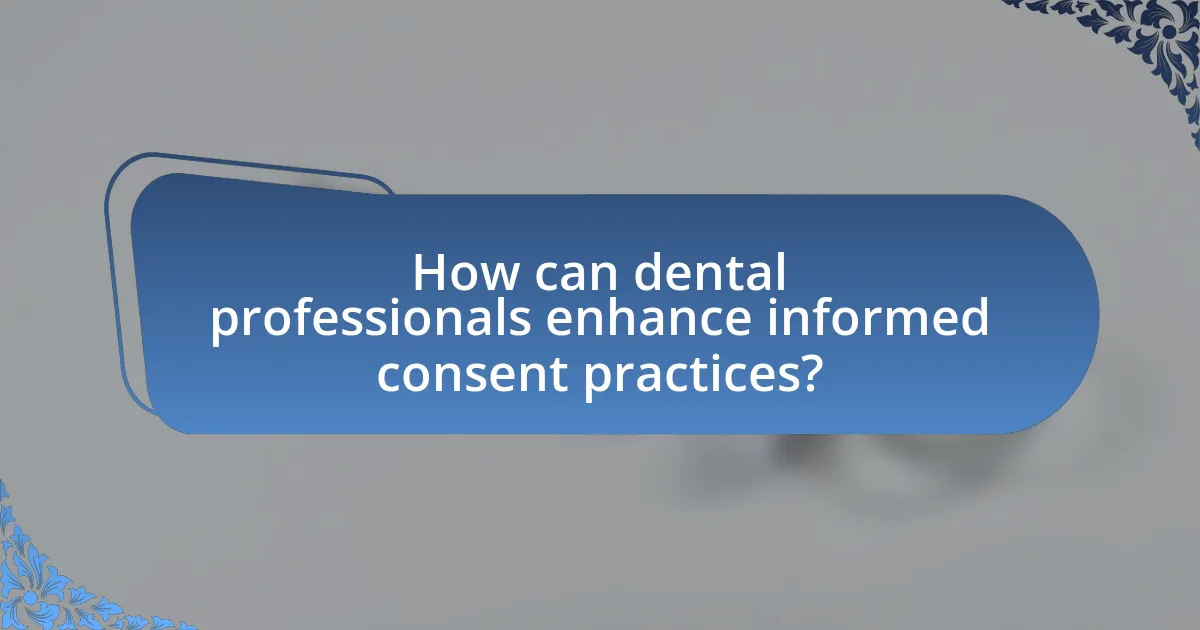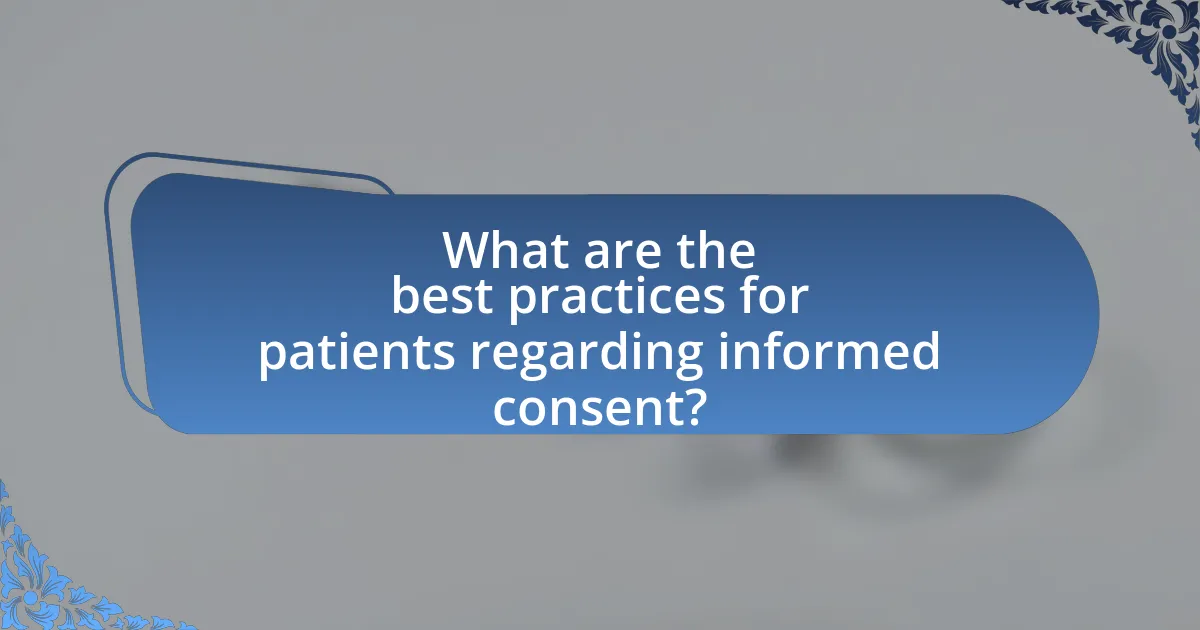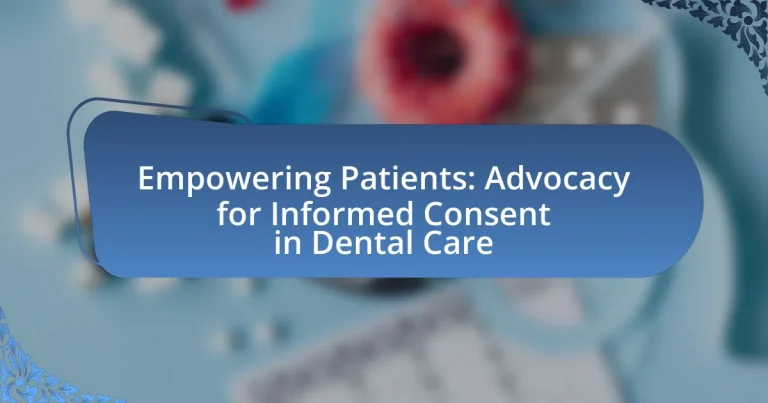Empowering Patients: Advocacy for Informed Consent in Dental Care is a critical process that ensures patients are fully informed about their treatment options, risks, and benefits before consenting to dental procedures. The article emphasizes the significance of clear communication between dental professionals and patients, highlighting how informed consent enhances patient autonomy, satisfaction, and adherence to treatment plans. It discusses the legal requirements for informed consent, the role of patients in the process, and the challenges faced, such as communication barriers and misconceptions. Additionally, it explores strategies for improving patient understanding, including the use of technology and educational resources, while providing practical tips for patients to effectively engage in their dental care decisions.

What is Empowering Patients: Advocacy for Informed Consent in Dental Care?
Empowering Patients: Advocacy for Informed Consent in Dental Care refers to the process of ensuring that patients are fully informed about their dental treatment options, risks, and benefits before consenting to procedures. This advocacy emphasizes the importance of clear communication between dental professionals and patients, enabling individuals to make educated decisions regarding their oral health. Research indicates that informed consent not only enhances patient autonomy but also improves treatment outcomes, as patients who understand their options are more likely to adhere to recommended care plans.
Why is informed consent important in dental care?
Informed consent is crucial in dental care because it ensures that patients are fully aware of the risks, benefits, and alternatives associated with their treatment options. This process empowers patients to make educated decisions regarding their oral health, fostering trust and collaboration between the patient and the dental professional. Research indicates that informed consent enhances patient satisfaction and adherence to treatment plans, as patients who understand their procedures are more likely to engage positively in their care. Furthermore, legal frameworks mandate informed consent, protecting both patients and practitioners by minimizing the risk of malpractice claims.
What are the legal requirements for informed consent in dentistry?
The legal requirements for informed consent in dentistry mandate that dental practitioners must provide patients with comprehensive information regarding their treatment options, risks, benefits, and alternatives before obtaining consent. This requirement is grounded in the principle of patient autonomy and is supported by legal precedents, such as the case of Canterbury v. Spence, which established that patients have the right to make informed decisions about their healthcare. Additionally, informed consent must be documented in writing, ensuring that the patient understands the information provided and voluntarily agrees to the proposed treatment.
How does informed consent impact patient autonomy?
Informed consent significantly enhances patient autonomy by ensuring that individuals have the right to make informed decisions regarding their healthcare. This process involves providing patients with comprehensive information about their diagnosis, treatment options, risks, and benefits, allowing them to weigh their choices based on personal values and preferences. Research indicates that when patients are actively involved in decision-making, their satisfaction with care increases, and they are more likely to adhere to treatment plans. For instance, a study published in the Journal of Medical Ethics found that informed consent practices lead to improved patient engagement and empowerment, reinforcing the principle that patients should have control over their own health decisions.
What role do patients play in the informed consent process?
Patients play a crucial role in the informed consent process by actively participating in decision-making regarding their dental care. This involvement includes understanding the nature of the proposed treatment, its risks and benefits, and alternative options available. Research indicates that when patients engage in discussions with their healthcare providers, they are more likely to make informed choices that align with their values and preferences, thereby enhancing their overall satisfaction with care. For instance, a study published in the Journal of Dental Research highlights that informed patients are more likely to adhere to treatment plans and experience better health outcomes.
How can patients effectively communicate their concerns and preferences?
Patients can effectively communicate their concerns and preferences by being clear, concise, and prepared during healthcare discussions. This involves actively listening to healthcare providers, asking questions, and expressing specific needs or worries related to their treatment. Research indicates that patients who prepare a list of questions and concerns prior to appointments are more likely to engage in meaningful dialogue, leading to better health outcomes. For instance, a study published in the Journal of Patient Experience found that patients who articulated their preferences were more satisfied with their care and felt more empowered in their treatment decisions.
What resources are available for patients to educate themselves about dental procedures?
Patients can educate themselves about dental procedures through various resources, including dental association websites, educational videos, and patient advocacy groups. The American Dental Association (ADA) provides comprehensive information on dental procedures, including descriptions, benefits, and risks, which can be accessed at ADA.org. Additionally, platforms like YouTube host educational videos created by dental professionals that visually explain procedures. Patient advocacy groups, such as the Oral Health America, offer resources and guides that empower patients to understand their dental care options. These resources collectively enhance patient knowledge and support informed consent in dental care.
What challenges exist in achieving informed consent in dental care?
Achieving informed consent in dental care faces several challenges, including patient comprehension, communication barriers, and time constraints. Patients often struggle to understand complex medical terminology and treatment options, which can lead to confusion and misinformed decisions. Research indicates that approximately 40% of patients do not fully understand the information provided during consultations, highlighting the need for clearer communication strategies. Additionally, language differences and varying health literacy levels can further complicate the consent process. Time constraints during appointments can limit the opportunity for thorough discussions, resulting in rushed explanations that may not adequately address patient concerns. These factors collectively hinder the effectiveness of informed consent in dental practice.
How do language barriers affect the informed consent process?
Language barriers significantly hinder the informed consent process by obstructing clear communication between healthcare providers and patients. When patients do not fully understand the information presented, they may struggle to comprehend the risks, benefits, and alternatives of a proposed treatment, leading to uninformed decisions. Research indicates that patients with limited English proficiency are less likely to understand medical instructions and consent forms, which can result in decreased satisfaction and increased anxiety regarding their care. A study published in the Journal of Health Communication found that language discordance between patients and providers is associated with lower rates of informed consent and poorer health outcomes.
What are the common misconceptions patients have about informed consent?
Common misconceptions patients have about informed consent include the belief that it is merely a formality, that signing a consent form equates to full understanding of the procedure, and that informed consent is only necessary for high-risk treatments. Patients often think that once they sign the document, they cannot change their minds or ask questions later. Research indicates that many patients do not fully grasp the information presented to them, leading to misunderstandings about the risks and benefits involved (Friedman et al., 2018, Journal of Medical Ethics). This highlights the need for clear communication and ongoing dialogue between healthcare providers and patients to ensure true informed consent.

How can dental professionals enhance informed consent practices?
Dental professionals can enhance informed consent practices by implementing clear communication strategies that ensure patients fully understand their treatment options, risks, and benefits. This can be achieved through the use of visual aids, simplified language, and interactive discussions that encourage patient questions. Research indicates that effective communication significantly improves patient comprehension and satisfaction, as evidenced by a study published in the Journal of Dental Education, which found that patients who received information through multiple formats were more likely to retain critical information about their dental procedures.
What strategies can dentists use to improve patient understanding?
Dentists can improve patient understanding by utilizing clear communication techniques, visual aids, and educational resources. Clear communication involves using simple language to explain procedures and treatment options, which helps patients grasp complex dental concepts. Visual aids, such as diagrams or videos, can enhance comprehension by providing a visual representation of the information being discussed. Educational resources, including brochures or online materials, can further support patient learning by offering detailed information that patients can review at their own pace. Research indicates that patients who receive information through multiple formats are more likely to understand their treatment options and make informed decisions about their care.
How can visual aids and written materials support informed consent?
Visual aids and written materials enhance informed consent by providing clear, accessible information that patients can easily understand. These tools help to break down complex medical terminology and procedures into simpler concepts, allowing patients to grasp the implications of their choices. For instance, studies have shown that using diagrams or illustrations can significantly improve patient comprehension of treatment options and risks, leading to more informed decision-making. Additionally, written materials can serve as a reference for patients to revisit after discussions with healthcare providers, reinforcing their understanding and retention of critical information.
What role does active listening play in the informed consent process?
Active listening is crucial in the informed consent process as it ensures that healthcare providers fully understand patients’ concerns and preferences. By engaging in active listening, providers can clarify information, address questions, and foster a trusting relationship, which is essential for patients to make informed decisions about their care. Research indicates that effective communication, including active listening, significantly enhances patient satisfaction and adherence to treatment plans, thereby improving overall health outcomes.
How can technology facilitate informed consent in dental care?
Technology can facilitate informed consent in dental care by providing interactive platforms that enhance patient understanding of procedures and risks. Digital tools such as patient education apps, virtual reality simulations, and online consent forms allow patients to access detailed information about their treatment options in an engaging manner. For instance, studies show that using multimedia presentations can improve patient comprehension and retention of information, leading to more informed decision-making. Additionally, electronic health records can streamline the consent process by ensuring that all relevant information is readily available and easily communicated between the dental team and the patient, thus reinforcing the informed consent process.
What digital tools are available for enhancing patient education?
Digital tools available for enhancing patient education include mobile health applications, online patient portals, and interactive educational websites. Mobile health applications, such as MyChart and HealthTap, allow patients to access their health information, schedule appointments, and receive educational materials tailored to their conditions. Online patient portals, like those provided by major healthcare systems, enable patients to view lab results, communicate with healthcare providers, and access educational resources. Interactive educational websites, such as MedlinePlus and the Mayo Clinic, offer comprehensive information on various health topics, including dental care, empowering patients to make informed decisions. These tools have been shown to improve patient engagement and understanding, ultimately leading to better health outcomes.
How can telehealth impact the informed consent process?
Telehealth can significantly impact the informed consent process by enhancing accessibility and convenience for patients. Through telehealth, patients can engage in consultations from their homes, which may lead to increased participation in the informed consent process. A study published in the Journal of Telemedicine and Telecare found that 70% of patients preferred telehealth consultations for discussing treatment options, indicating that remote access can facilitate better understanding and communication. Additionally, telehealth platforms often provide digital documentation, allowing for clearer presentation of consent forms and educational materials, which can improve patient comprehension and retention of information. This shift towards digital interactions can streamline the informed consent process, making it more efficient while ensuring that patients are adequately informed about their treatment options.

What are the best practices for patients regarding informed consent?
The best practices for patients regarding informed consent include actively seeking clear and comprehensive information about their treatment options, risks, and benefits. Patients should ask questions to ensure they fully understand the procedures and implications, as well as their rights to refuse or withdraw consent at any time. Engaging in discussions with healthcare providers fosters a collaborative decision-making process, which is essential for informed consent. Research indicates that effective communication between patients and providers significantly enhances patient understanding and satisfaction, ultimately leading to better health outcomes.
How can patients prepare for their dental appointments to ensure informed consent?
Patients can prepare for their dental appointments to ensure informed consent by gathering relevant medical history, understanding the proposed treatment options, and formulating questions for the dentist. Collecting medical history, including allergies and previous dental procedures, allows patients to provide essential information that may affect treatment decisions. Familiarizing themselves with treatment options helps patients comprehend the benefits, risks, and alternatives, which is crucial for making informed choices. Additionally, preparing specific questions about the procedure, potential side effects, and costs enables patients to engage in meaningful discussions with their dentist, ensuring clarity and understanding before consenting to treatment.
What questions should patients ask their dentists before procedures?
Patients should ask their dentists about the specific procedure being performed, including its purpose, benefits, risks, and alternatives. Understanding the procedure helps patients make informed decisions regarding their dental care. Additionally, patients should inquire about the expected duration of the procedure, any necessary aftercare, and the costs involved, including insurance coverage. These questions ensure that patients are fully aware of what to expect and can advocate for their own health effectively.
How can patients verify the information provided by dental professionals?
Patients can verify the information provided by dental professionals by seeking second opinions from other licensed dental practitioners. This approach allows patients to compare treatment recommendations and diagnoses, ensuring they receive accurate and reliable information. Additionally, patients can consult reputable dental associations, such as the American Dental Association, which offers resources and guidelines on various dental procedures and standards of care. Research indicates that obtaining a second opinion can lead to different treatment options in up to 30% of cases, highlighting the importance of verification in dental care.
What common pitfalls should patients avoid during the informed consent process?
Patients should avoid rushing through the informed consent process, as this can lead to misunderstandings about their treatment. Taking time to thoroughly review and ask questions about the procedure, risks, benefits, and alternatives is crucial for making an informed decision. Additionally, patients should avoid signing consent forms without fully understanding the information presented, as this can result in unintended consequences. Research indicates that clear communication and patient engagement significantly enhance understanding and satisfaction in healthcare decisions, underscoring the importance of avoiding these pitfalls.
How can patients recognize when they are not fully informed?
Patients can recognize when they are not fully informed by identifying gaps in their understanding of treatment options, risks, and benefits. If patients feel uncertain about their diagnosis or treatment plan, or if they have unanswered questions after discussions with their healthcare provider, it indicates a lack of comprehensive information. Research shows that effective communication between patients and providers is crucial; studies indicate that patients who actively engage in discussions and seek clarification are more likely to feel informed. Additionally, if patients notice that their provider does not encourage questions or fails to provide detailed explanations, this can signal insufficient information.
What steps can patients take if they feel pressured during the consent process?
Patients who feel pressured during the consent process should first communicate their discomfort to the healthcare provider. This step is crucial as it allows the provider to understand the patient’s concerns and potentially alleviate any pressure. Additionally, patients can request more time to consider their options, ensuring they fully understand the implications of the consent. Seeking a second opinion from another healthcare professional can also provide clarity and reassurance. Furthermore, patients have the right to refuse consent if they feel uncertain or coerced, as informed consent is based on voluntary agreement. These actions are supported by ethical guidelines in healthcare, which emphasize the importance of patient autonomy and informed decision-making.
What practical tips can empower patients in their dental care decisions?
Patients can empower themselves in their dental care decisions by actively seeking information, asking questions, and understanding their treatment options. Research indicates that informed patients are more likely to engage in their care and make decisions aligned with their values and preferences. For instance, studies show that patients who ask their dentists about the risks and benefits of procedures report higher satisfaction and better outcomes. Additionally, utilizing resources such as dental associations and educational materials can provide clarity on procedures and costs, further enhancing decision-making.


